Where is Valid 17 Digit Easy Rebate Id
How to Fill out the IRS Non-filer Form
Use the form if you are not planning to file a 2020 federal tax return to get your Child Tax Credit or Stimulus Checks.

GetCTC.org is a mobile-friendly, easy-to-use tool to get your Child Tax Credit and missing stimulus payments, even if you don't have your tax documents. Consider using GetCTC instead of the IRS Non-Filer Form as a simpler option.
You can access the following Guide to the IRS Non-filer Form as Google Slides that can be printed.
Because of a recent law, more families qualify and will get money from the Child Tax Credit (CTC), even those that don't have income. You could get up to $3,600 per child. You will get half of this money in 2021 as an advance payment and half in 2022.
Even if you don't owe taxes or have no income, you can still get this full tax credit. Fill out the IRS Non-filer tool to get the advance CTC or missed stimulus checks if you are don't need to file a 2020 tax return.
If your child aged 17 or under with a Social Security Number lives with you, you likely qualify for the CTC. If you already received your stimulus checks, the IRS has your information – do nothing. Full rules below.
Getting started
The Non-filer form takes 15-30 minutes to complete if you have everything listed below.
To complete the form, you will need:
- A computer or cell phone with access to the internet: the form does not work well on phones. You'll need to scroll right and left to complete all the form fields.
- Full legal name
- Your SSN or ITIN and SSNs of your qualifying children
- Date of Birth
- Mailing address: If you are unhoused or don't have a permanent address, ask your local shelter or service provider. If you can't find one, you can also ask to use a trusted relative's or friend's address. The IRS will deliver checks to P.O. boxes.
- Email address: If you don't remember or have the password to your email, you can create a new email address for free through a website like Gmail, Yahoo! Mail, or AOL.
- Bank Account direct deposit/routing number (optional): Direct deposit is the quickest and safest way to get your payment. If you don't have a bank account, you can still get your payment through direct deposit using a prepaid reloadable debit card, CashApp, Venmo, or PayPal, or opening an online bank account. If you cannot use these options, you'll get your payment as a paper check.
Step 1: Visit the IRS website to access the Non-filer form
Scroll to the bottom of this IRS portal: https://www.irs.gov/credits-deductions/child-tax-credit-non-filer-sign-up-tool
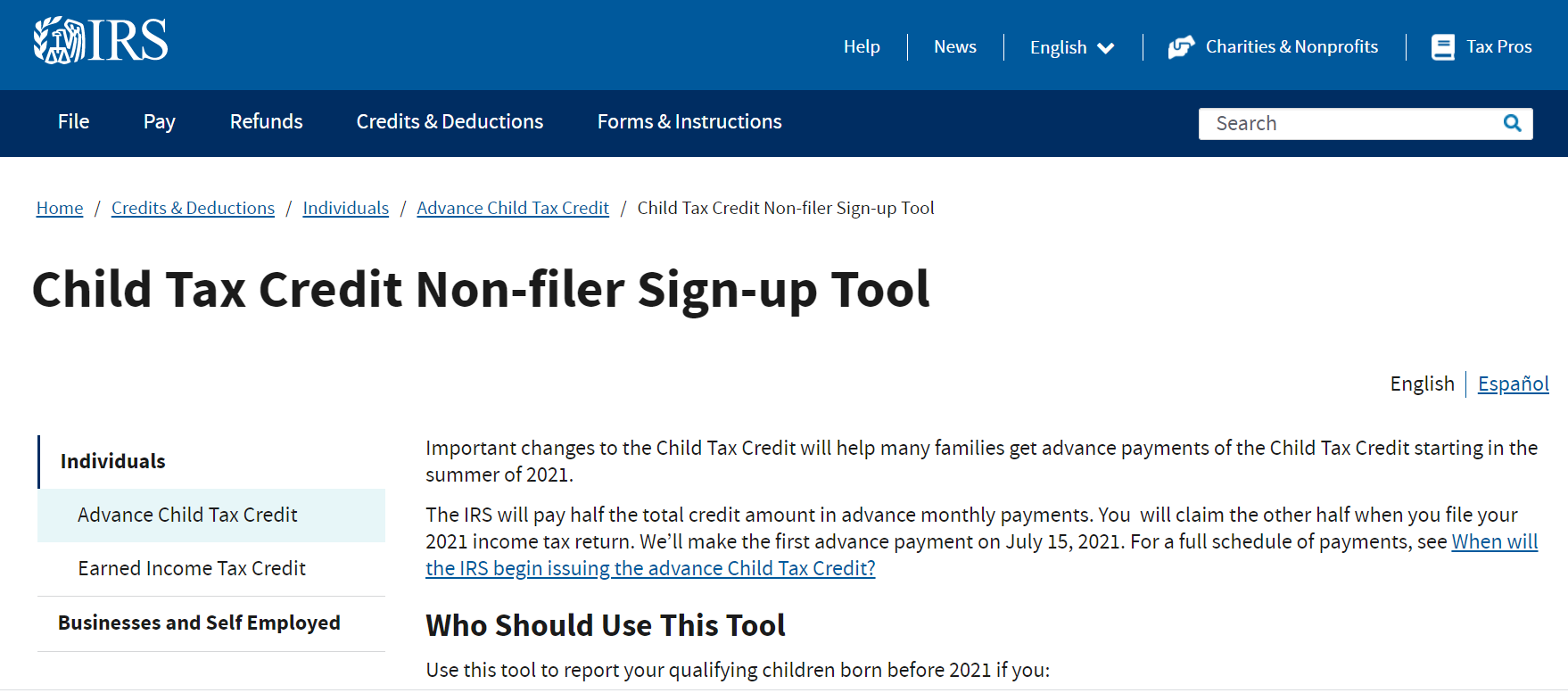
Click the blue "Use the Non-filer Sign-up Tool" button.
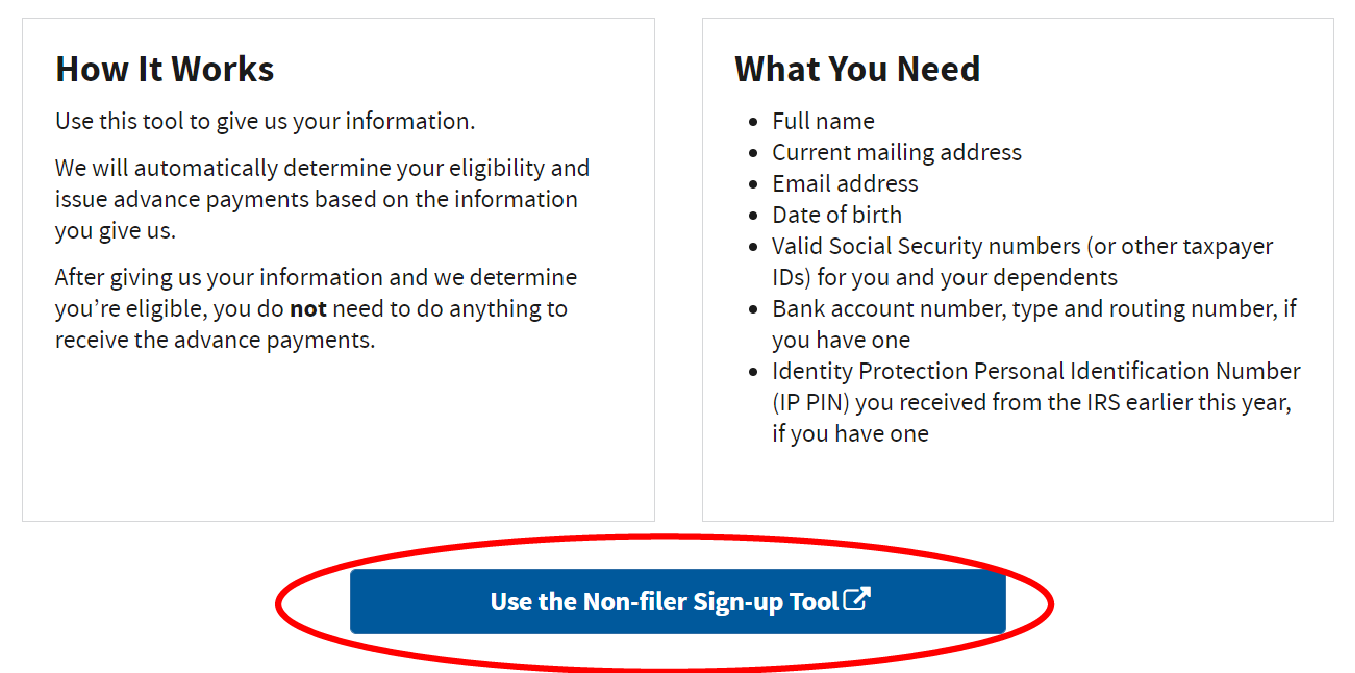
You will be taken to this page: https://www.freefilefillableforms.com/#/fd/childtaxcredit
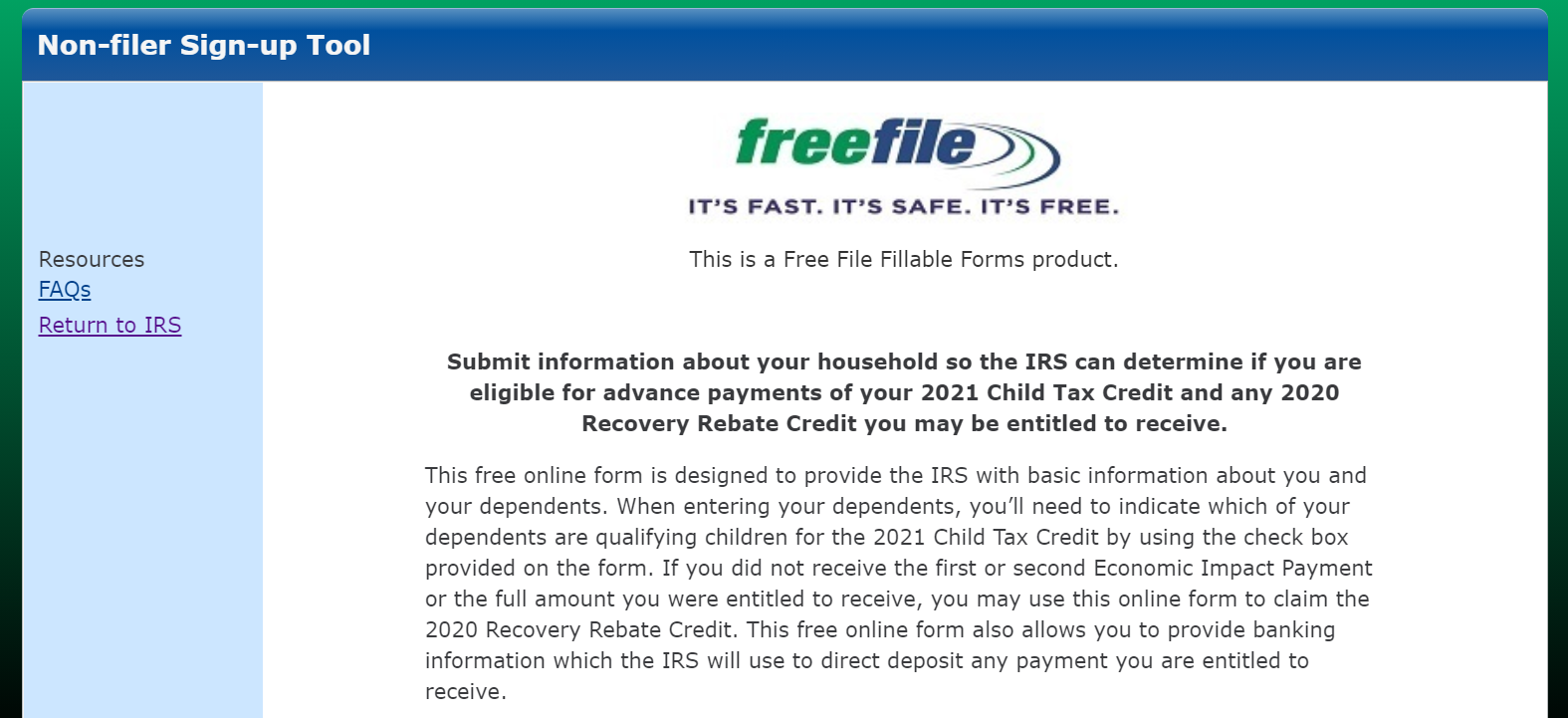 Click the blue "Get Started" button.
Click the blue "Get Started" button.
Step 2: Create an account
Fill out the information to create an account.
- Email address: use an email address that you have access to. You will need to check your email to verify your address before submitting the form. You will receive an email confirmation after submitting the form.
- User ID
- Phone number: while not required, it is recommended and can be used to help you access your account if you forget your password.
- Password: requires both upper- and lower-case letters, 8 characters, a number, and a symbol. Choose a phrase that you can remember or write down your password in a secure place.
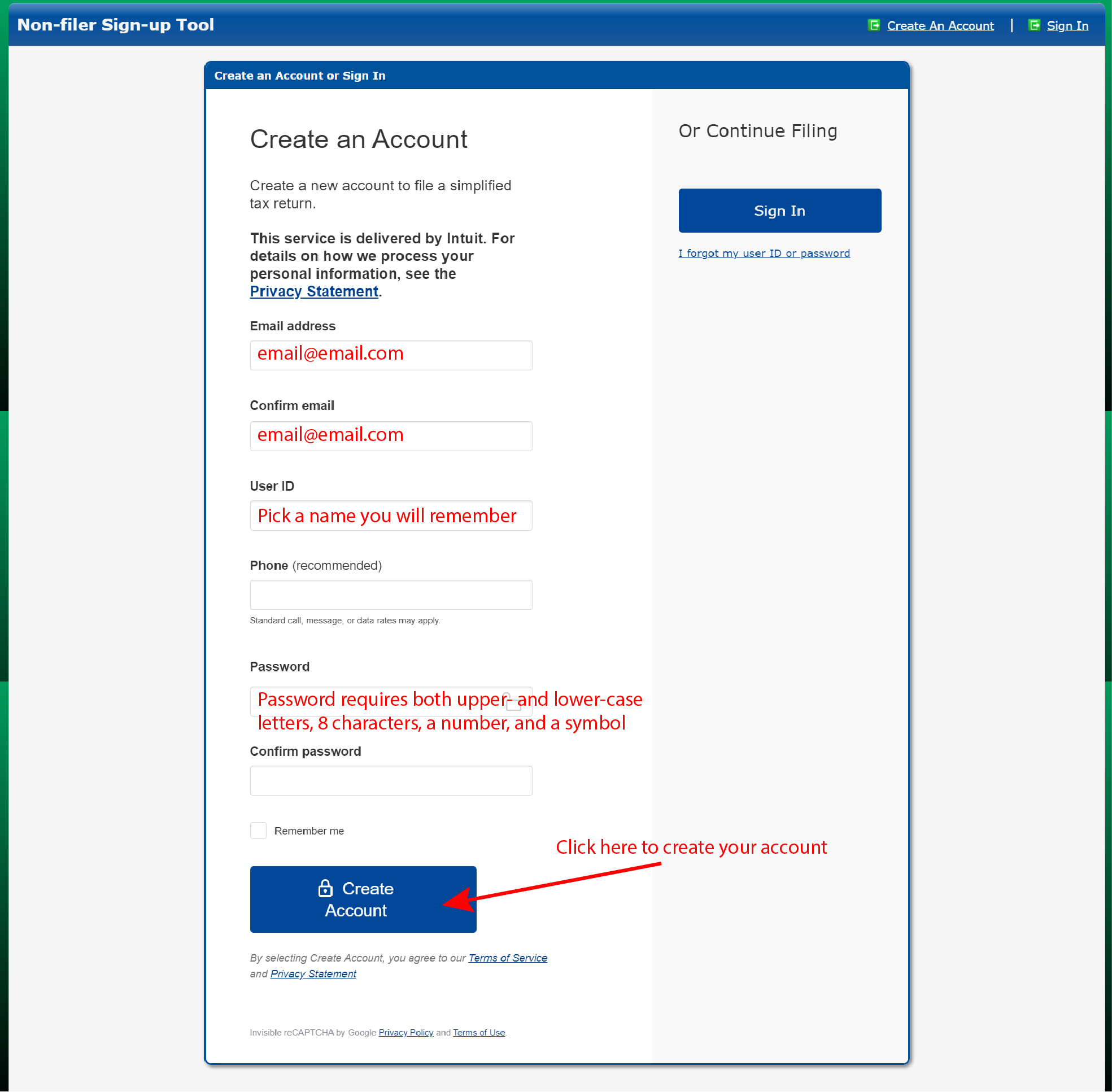
Once you complete the form and click the blue "create account" button, you will see an account confirmation page. Hit the "Continue" button to begin completing the form.
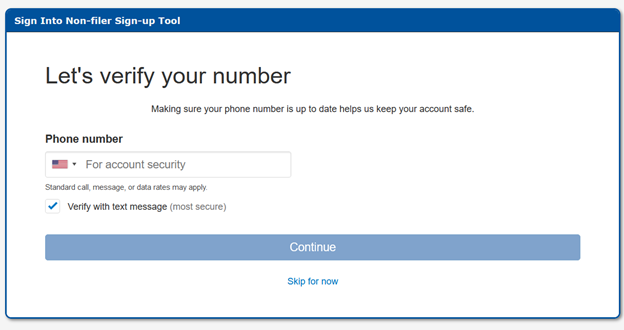
Note: If you don't use the form for 20 minutes, it will time out and you will see the following a message that says "We have logged you out. We do this automatically if you haven't used Non-Filers: Enter Payment Info in the last 20 minutes."
Step 3: Fill out filing status, claim dependents, and provide banking information
For "STEP 1. Fill Out Your Tax Forms," there is required and optional information to complete. Skip the optional fields if they do not apply to you.
Required:
- Filing Status (Single or Married filing jointly)
- First name, middle initial, and last name
- Social Security Number (SSN) or Individual Identification Number (ITIN)
- Home address
- Dependents in 2020: First and last name, SSN, relationship to you. Check the box if they qualify for the CTC.
Note: these fields are required for both you and your spouse if you are married filing jointly. If you have a new qualifying child in 2021, you will be able to provide their information in a separate tool this summer.
Optional info:
- Check the box if you or your spouse can be claimed by someone else as a dependent
- Recovery Rebate Credit amount : If you didn't get the full first or second stimulus check, you can enter the amount you are owed (full instructions below)
- Bank account routing info: If you leave this blank, your payments will be mailed.
- Identity Protection PIN: only include if the IRS provided you a number because you've experienced identity theft.
After entering all the information that relates to you, click "Continue to Step 2".
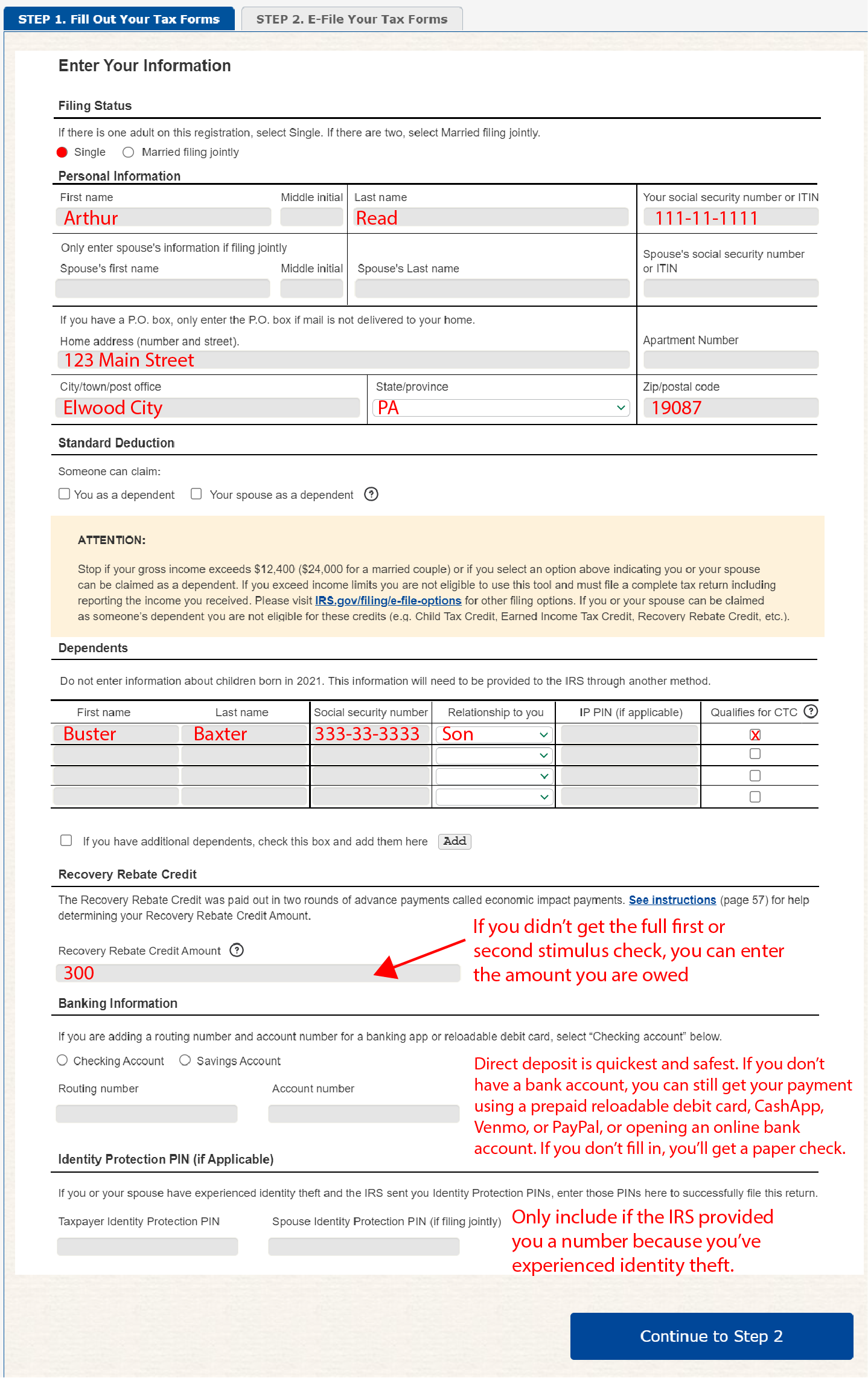
Didn't get your full stimulus check?
If you didn't receive your full first or second stimulus check, you can enter your Recovery Rebate Credit amount to get your money. Be sure you know the exact amount you received. If you don't enter the right amount, your CTC and stimulus checks may be delayed.
To find the amount of stimulus payment(s) you've received, you can refer to the IRS notices that were mailed to you.IRS Notice 1444 shows how much you received from the first stimulus check andIRS Notice 1444-B shows how much you received from the second stimulus check. You can also check your bank statements if you had your payments direct deposited. If you no longer have the IRS notice(s) or received a paper check, you can provide this information based on memory. The IRS will correct the amount for you if you made a mistake. However, this can slightly delay the processing of your tax return. The IRS will notify you of any changes made to your tax return.
Here's how you calculate how much you are owed.
1. First, look up how much you received with your first and second stimulus checks. Add these two amounts.
2. Second, figure out how much you qualify for. Add the amounts for your first and second stimulus check.
First stimulus check: $1,200 (single) OR $2,400 (married) + $500 per dependent
Second stimulus check: $600 (single) OR $1,200 (married) + $600 per dependent
3. Finally, subtract the amount you received from the amount you are owed.
Step 4: Fill out income and personal identification information
"STEP 2 E-file your tax forms," requests both required and optional information.
Required:
- Personal verification: The form asks for your 2019 Adjusted Gross Income. If you did NOT file taxes last year, enter "0" in the box. Ignore part B which asks for last year's self-selected signature PIN.
- Date
- Electronic signature: Instead of signing your name, your signature is a 5-digit PIN number that you create.
- Date of birth
Note: these fields are required for you and your spouse if you are married filing jointly.
Optional:
- Cell phone number
- Driver's license or state issued ID number, state, issue date, and expiration date – leave blank if you (or your spouse if married filing jointly) don't have one
Step 5: Verify your email
Before you can submit your form, you must verify your email address. On "STEP 2 E-file your tax forms," scroll to the bottom of the page. Click the "Update Your Account" link.
That will take you to the following page. Click the "Verify email" link. Then click on "Send verification email."
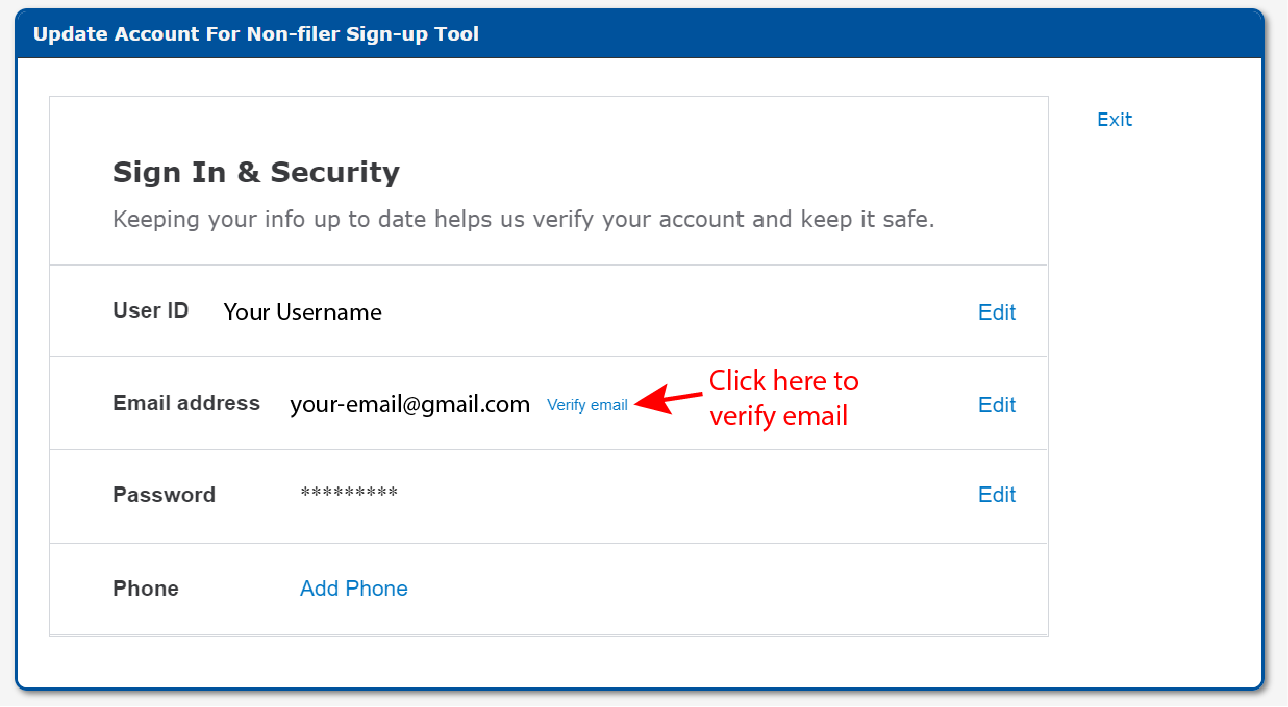
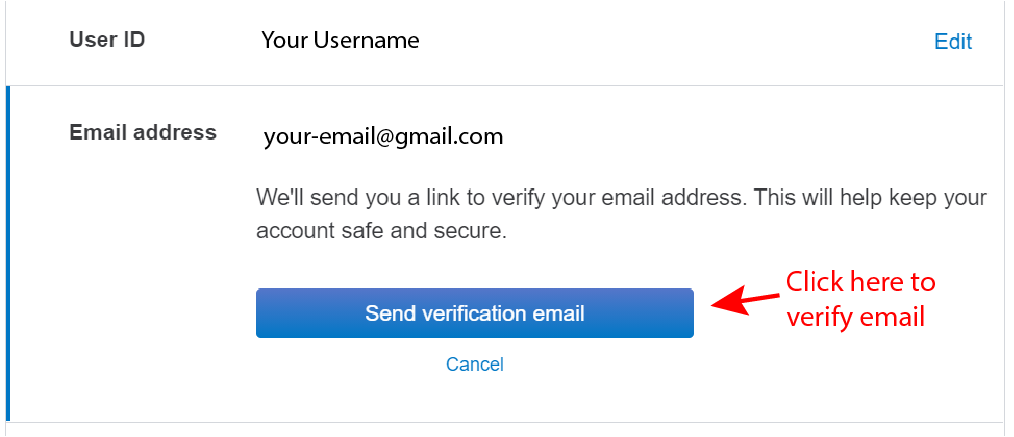 Check your email. You will receive a message from the sender "Non-filer Sign-up Tool" with the subject line "Your Non-filer Sign-up Tool – Account". The message will look like this:
Check your email. You will receive a message from the sender "Non-filer Sign-up Tool" with the subject line "Your Non-filer Sign-up Tool – Account". The message will look like this:
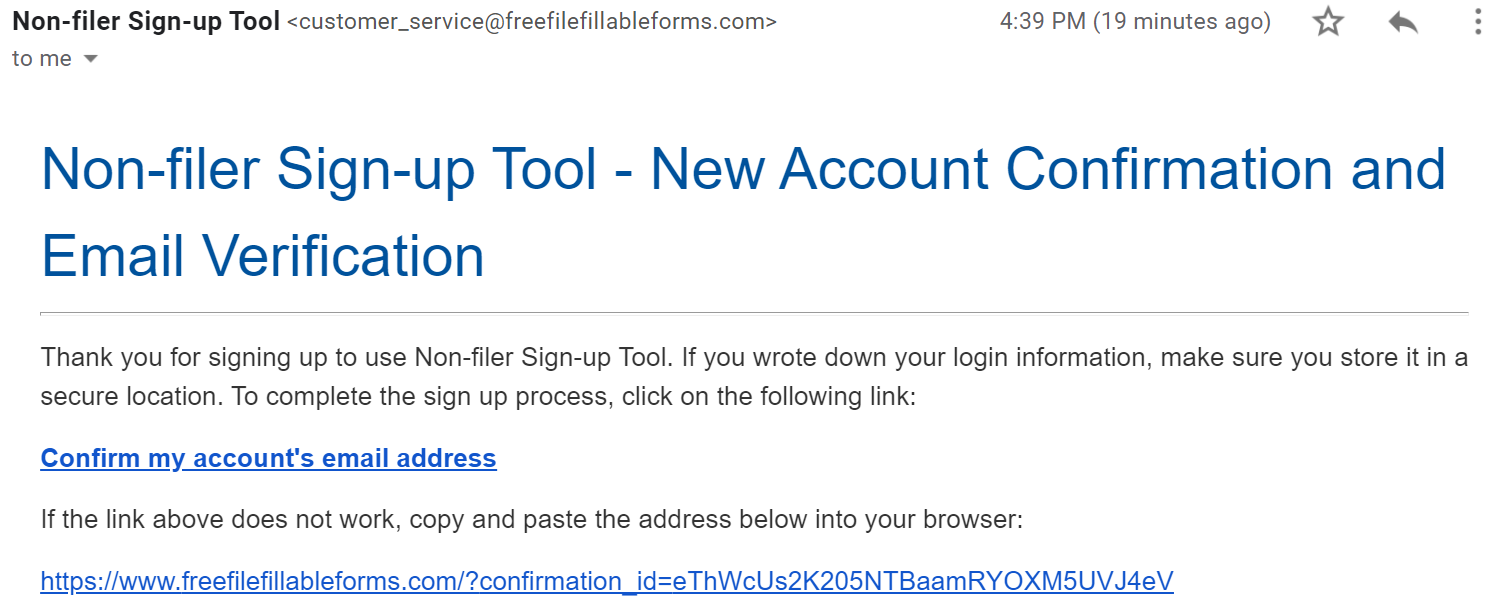
Click on "Confirm my account's email address." You will then see this confirmation screen:
Step 6: Submit your form
Click the blue "Continue to E-file" button. If you've entered all the necessary information, you'll be see a captcha verification page. Fill in the code.
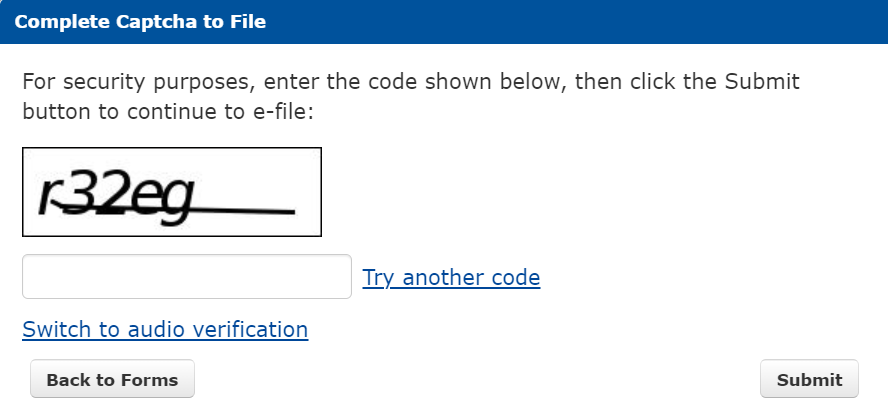
Another screen will appear with a disclosure statement. Check "I agree" and "Transmit my Return" to submit.
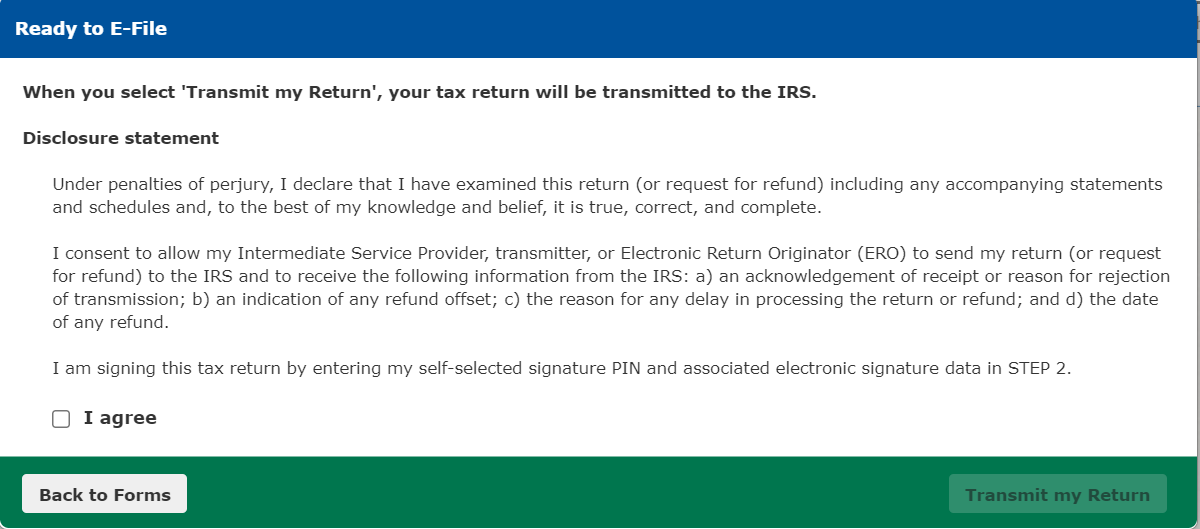
After you submit your form, you will receive an email to confirm successful transmission. You'll get a separate email acknowledging that the IRS accepted or rejected your submission. This can take up to 48 hours. You can also view the status of your submission at any time by signing into the Non-filer Sign-up Tool and clicking the 'Check E-File Status' button.
Additional help
If you need more guidance to complete the Non-filer form, see the Free File Fillable Forms FAQs.
For questions about Child Tax Credit payments, call your local 211.For information about the Child Tax Credit and advance payments, visit the federal government's main page for information: 2021 Child Tax Credit and Advance Child Tax Credit Payments Frequently Asked Questions
Recommended for you
The latest
Source: https://www.taxoutreach.org/tax-filing/coronavirus/how-to-fill-out-the-irs-non-filer-form/

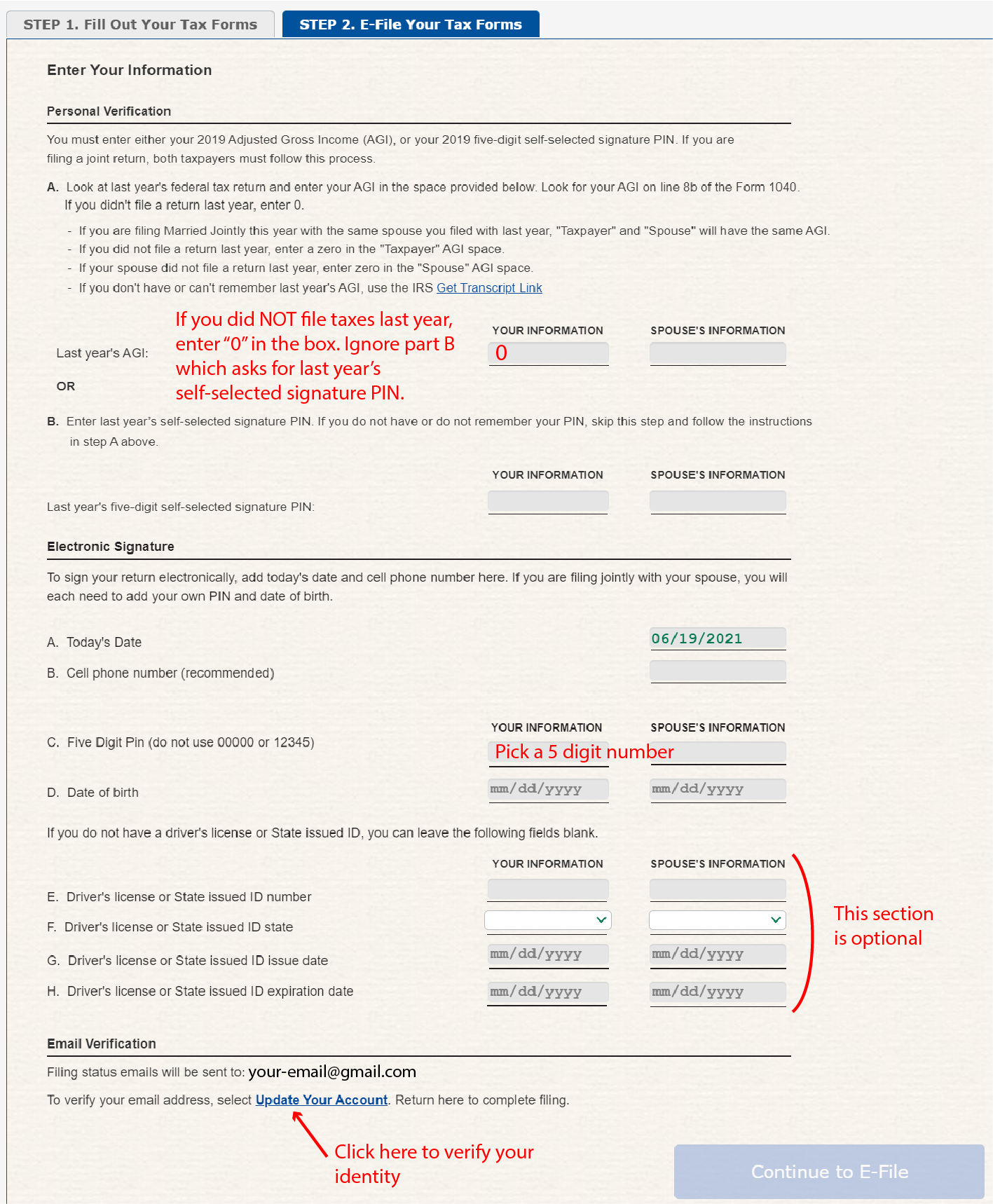
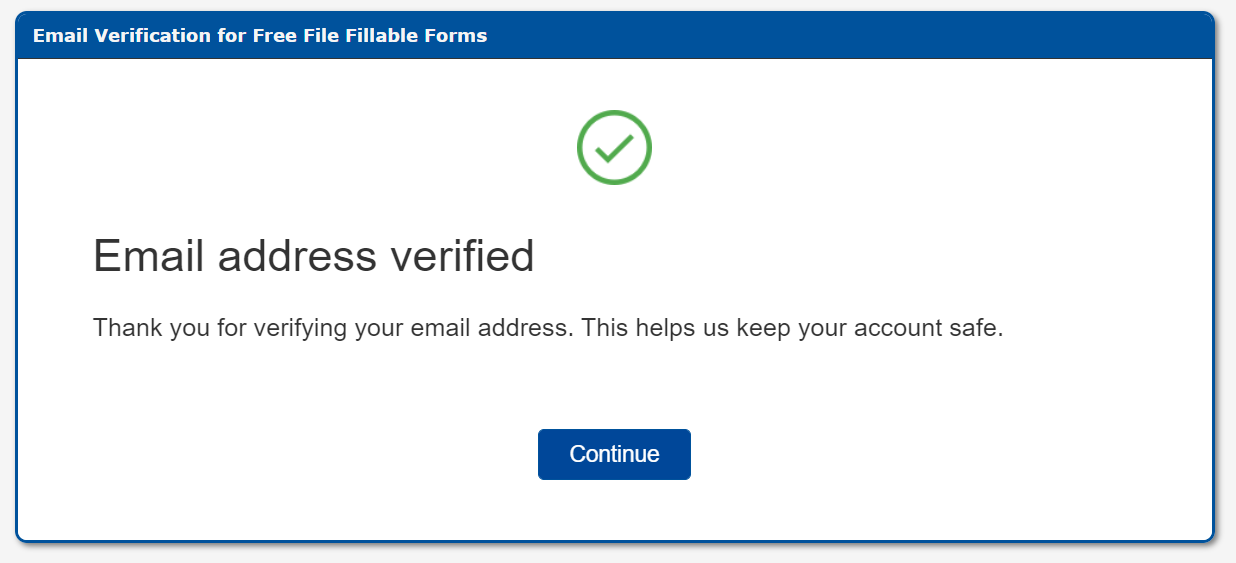
0 Response to "Where is Valid 17 Digit Easy Rebate Id"
Post a Comment